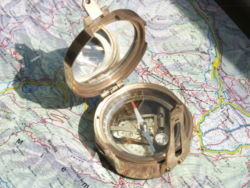Difference between revisions of "AY Honors/Forestry/Answer Key"
| Line 25: | Line 25: | ||
==Manufacturers== | ==Manufacturers== | ||
| − | * [http://www.soil.co.uk Soil Instruments (UK) Ltd - Geotechnical Instrumentation] | + | * [http://www.soil.co.uk Soil Instruments (UK) Ltd - Geotechnical Structural Instrumentation] |
* [http://pewa.panasonic.com/pcsd/product/sens/acce_sensor.html Panasonic Electric Works Corporation of America] | * [http://pewa.panasonic.com/pcsd/product/sens/acce_sensor.html Panasonic Electric Works Corporation of America] | ||
Revision as of 15:48, 12 June 2007
An inclinometer or clinometer is an instrument for measuring angles of slope (or tilt), elevation or inclination of an object with respect to gravity. It is also known as a tilt meter, tilt indicator, slope alert, slope gauge, gradient meter, gradiometer, level gauge, level meter, and pitch & roll indicator.
More particularly, an inclinometer can refer to:
- An instrument used to determine the angle of the earth's magnetic field in respect to the horizontal plane.
- An instrument for showing the inclination of an aircraft or ship relative to the horizontal. An airplane instrument. See turn coordinator or slip indicator[1].
- An instrument for showing a deviation from the true vertical or horizontal
- An instrument used by surveyors in order to measure an angle of inclination or elevation
- Compass with inclinometer
- An inclinometer is used as a rollover warning, to alert equipment operator of possible tip over condition.
- Any of various surveying instruments for measuring angles of elevation, slope, or incline, as of an embankment. Also called a clinometer.
- An instrument for measuring slight differences in slopes, particularly for geophysics. Such inclinometers are, for instance, used for monitoring volcanoes, or for measuring the depth and rate of landslide movement.
- An inclinometer may also be used in civil engineering projects to measure movements in walls and/or the ground.
- An instrument for determining the dip of beds or strata, or the slope of an embankment or cutting; a kind of plumb level.
- An instrument used by surveyors in order to measure an angle of inclination or elevation
- An inclinometer may also be used in some automotive safety systems.
Tilt sensors and inclinometers generate an artificial horizon and measure angular tilt with respect to this horizon. They are used in cameras, aircraft flight controls, automobile security systems, and special switches. Also used for platform leveling, boom angle indication, anywhere tilt requires measuring. Important specifications to consider when searching for tilt sensors and inclinometers are the tilt angle range and number of axes. The tilt angle range is the range of desired linear output measured in degrees. The number of axes the inclinometer and tilt sensor measure on is another important specification.
Common sensor technologies for tilt sensors and inclinometers are accelerometer, Liquid Capacitive, electrolytic, gas bubble in liquid, and pendulum.
Tilt sensor technology has also been implemented in video games. Yoshi Topsy-Turvy and Kirby Tilt 'n' Tumble are both built around a tilt sensor mechanism, which is built into the cartridge. The PlayStation 3's game controller also utilizes tilt as a means to play video games.
Manufacturers
Usages
Clinometers are used for:
- indicating pitch and roll of vehicles, sail boats, and aircraft.
- Monitoring boom angle of cranes and material handlers.
- Measuring the "look angle" of a satellite antenna towards a satellite.
- Measuring the slope angle of a tape or chain during distance measurement.
- Estimating the height of a building, tree, or other feature using a vertical angle and a distance (determined by taping or pacing).
- Measuring the angle of drilling in well-logging applications.
- Measuring the height of trees or other poles
- Measuring steepness of a ski slope. (<10 deg for beginners, 10-20 "green", 15-25 "blue", 25-35 "black", 35-45 "double black")
Factors which influence the use of clinometers
(Overall accuracy varies depending on the type of inclinometer and technology utilized)
- Gravity
- temperature (drift), zero offset, linearity, vibration, shock, cross-axis sensitivity, acceleration/deceleration
- A clear line of sight between the user and the measured point is needed.
- A well defined object is required to obtain the maximum precison.
- The angle measurement precision and accuracy is limited to slightly better than one degree of arc .
Survey methods used for
- Clinometers are used for the measurement of angles in reference to gravity.
- The USDA Forest Service uses clinometers to measure tree height in its Forest Inventory and Analysis program.

